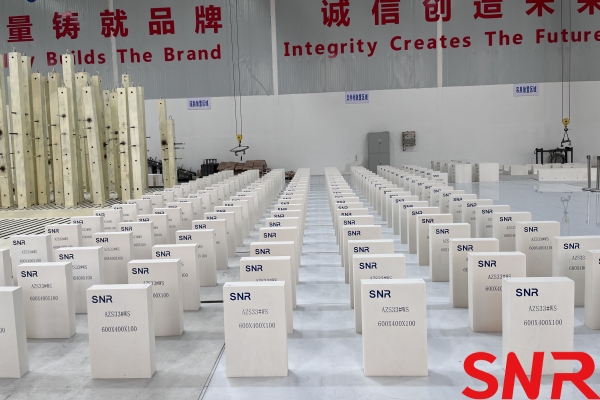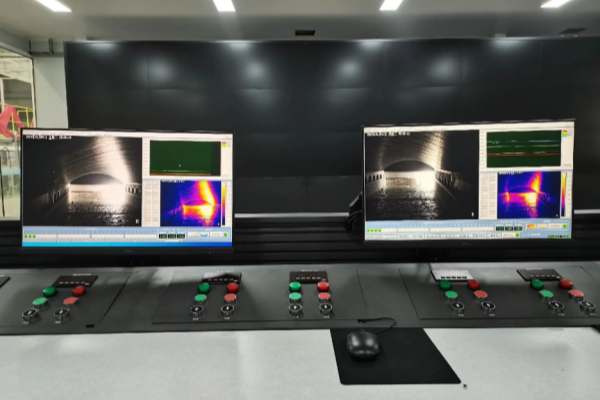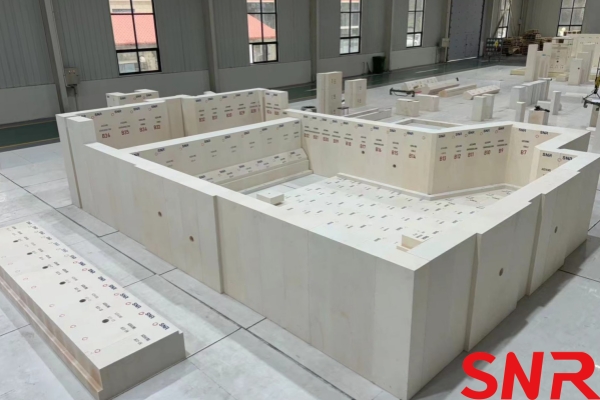The glass furnace is a critical piece of equipment in the glass production process, with a typical service life of 8 to 12 years. However, in practice, the furnace‘s lifespan is influenced by various factors and may not reach its designed life. Therefore, studying the factors affecting the service life of glass furnaces and adopting correct operation and maintenance measures are of great significance for improving production efficiency and reducing costs.
1.Factors Affecting the Service Life of Glass Furnaces
2.How to Extend the Service Life of Glass Furnaces
3.Case Analysis
4.Summary
1. Factors Affecting the Service Life of Glass Furnaces
(1) Design Quality
Design is the foundation of a glass furnace and directly impacts its service life. A good design requires comprehensive consideration of multiple disciplines, including mechanics, thermodynamics, fluid dynamics, and refractory materials science. Design quality is mainly reflected in the following aspects:
- Structural Rationality: The furnace‘s structural design must ensure that refractory materials in each part can withstand high temperatures, chemical erosion, and mechanical stress. For example, a reasonable flame space design can reduce the erosion of side walls.
- Temperature Control: The design should ensure flexible and stable temperature control to avoid thermal stress on refractory materials caused by temperature fluctuations.
- Refractory Material Configuration: Refractory materials for different parts should be selected based on their working conditions. For instance, high-erosion-resistant AZS-41# materials should be used for the throat and electrode blocks.
(2) Quality of Refractory Materials
Refractory materials are a crucial component of the glass furnace, and their quality directly affects its service life. The selection of refractory materials should consider the following factors:
- Material Properties: The erosion resistance, thermal shock resistance, and thermal expansion coefficient of refractory materials must meet design requirements.
- Material Compatibility: Refractory materials for different parts should be properly matched. For example, high-quality refractory bricks should be used for key areas such as the tank walls, tank bottom, and crown.
- Supplier Selection: Refractory materials from reputable manufacturers should be prioritized, ensuring they comply with national standards.


(3) Construction Quality
Construction quality is a key factor affecting the furnace‘s service life. The following points should be noted during construction:
- Brickwork Quality: The bricklaying of refractory materials must ensure full mortar filling, with brick joints meeting design requirements to avoid early damage caused by excessive gaps.
- Arch Form-work: The fabrication and installation of furnace arch form-work must be reasonable to ensure uniform brick joints and prevent cracks caused by uneven heating.
- Expansion Joints: Appropriate expansion joints should be reserved based on the thermal expansion coefficient of refractory materials to prevent brick cracking due to thermal expansion.
(4) Baking Process
Baking is a critical step before the furnace is put into operation. A proper baking process can effectively extend the furnace‘s service life. The following points should be noted during baking:
- Heating Curve: A reasonable heating curve should be formulated based on the characteristics of refractory materials to avoid thermal stress caused by rapid heating.
- Temperature Uniformity: The temperature field inside the glass furnace should be uniform during baking to avoid local overheating or underheating.
- Steel Structure Adjustment: The glass furnace‘s steel structure should be adjusted in a timely manner during baking to ensure its stability.
(5) Operation and Maintenance
Operation and maintenance are essential for ensuring the furnace‘s service life. The following points should be noted during operation:
- Temperature Control: Maintain stable melting temperatures to avoid significant temperature fluctuations.
- Batch Management: Control the amount and method of batch charging to minimize impact and erosion on refractory materials.
- Bubbler System Maintenance: Regularly check the frequency and bubble size of the bubbler system to ensure its proper operation.
- Cleaning and Maintenance: Regularly clean ash and impurities inside the furnace to prevent erosion of refractory materials.
- Hot and Cold Repairs: During the later stages of furnace operation, use hot or cold repair techniques to maintain key areas, such as patching side wall blocks.
2.How to Extend the Service Life of Glass Furnaces through Proper Operation
(1) Optimized Design
Structural Design: Design a reasonable furnace structure based on the glass formula and production requirements to reduce the erosion of refractory materials.
Refractory Material Selection: Select appropriate refractory materials according to the working conditions of different parts of the furnace. For example, use AZS-33# for the furnace bottom and AZS-41# for the throat.
Temperature Control System: Design a flexible temperature control system to ensure temperature stability and adjustability.
(2) Strict Construction Management
Worker Training: Construction personnel must undergo professional training to understand the properties of refractory materials and construction requirements, ensuring construction quality meets design standards.
Construction Supervision: Establish a strict supervision mechanism to inspect and approve each construction process, ensuring quality. Key steps such as refractory brick laying, expansion joint reservation, and arch formwork fabrication must strictly follow construction specifications.
Material Inspection: Conduct rigorous quality inspections on incoming refractory materials to ensure they meet design requirements and national standards. The use of substandard materials is strictly prohibited to avoid shortening the furnace‘s service life due to material quality issues.
Construction Records: Maintain detailed records of construction data and operations to provide a reference for future maintenance and repairs.
(3) Scientific furnace baking Process
Reasonable Heating Curve: Develop a scientific heating curve based on the furnace structure and refractory material properties. The heating process should be slow and uniform to avoid thermal stress-induced cracks or spalling in the refractory materials.
Temperature Monitoring and Control: Install temperature sensors to monitor the internal temperature distribution in real-time during the baking process. Use an automated control system to ensure uniform temperature distribution and avoid localized overheating or underheating.
Inspection and Adjustment During Baking: Regularly inspect structural changes and the heating condition of refractory materials, addressing any issues promptly. For example, check expansion joints to ensure proper sizing and adjust steel structures to prevent deformation caused by thermal expansion.
Cooling After baking: After baking, perform slow cooling to avoid thermal stress concentration in refractory materials due to rapid cooling. Ensure proper ventilation inside the furnace while avoiding direct cold air exposure to refractory surfaces to prevent damage from excessive temperature differences.
(4) Standardized Operation
Temperature Control: Maintaining a stable melting temperature is key to extending glass furnace life. Operators should adjust the combustion system based on the glass melting condition and furnace operation status to ensure temperature uniformity and stability. Avoid excessive temperature fluctuations that increase thermal stress on refractory materials and accelerate damage.
Charging Management: Control the amount and method of charging to minimize impact and erosion on refractory materials. Charging should be uniform and continuous to avoid localized temperature drops from concentrated charging. Ensure raw material quality and purity to prevent chemical erosion of refractory materials by impurities.
Bubbler System Maintenance: The bubbler system is an important auxiliary device in the glass melting process, and its proper operation can improve glass liquid convection and melting efficiency. Regularly check the frequency and bubble size of the bubbler system to ensure normal operation. Prevent clogging due to prolonged operation, which could affect its performance.
Flame Management: Adjust the shape and length of the combustion flame to ensure uniform coverage of the melting zone, avoiding localized overheating or underheating. The flame shape and length should be flexibly adjusted based on the furnace structure and glass melting conditions to achieve optimal melting efficiency while reducing refractory erosion.
Furnace Atmosphere Control: Maintain a proper atmosphere inside the furnace to avoid chemical erosion of refractory materials caused by excessive oxidation or reduction. Adjust the air-to-fuel ratio to control the oxidation-reduction atmosphere, ensuring the longevity of refractory materials.


(5) Effective Maintenance
Regular Inspection and Maintenance: Establish a regular inspection system to comprehensively check all parts of the furnace. Focus on refractory material wear, steel structure deformation, and combustion system operation. Address issues promptly to prevent minor problems from escalating into major failures that affect furnace life.
Cleaning and Maintenance: Regularly clean accumulated dust and impurities inside the furnace to prevent erosion of refractory materials. Key areas such as the throat and electrode bricks should be cleaned and maintained regularly to ensure proper operation. External equipment like fans and pipelines should also be maintained to ensure operational efficiency.
Hot and Cold Repair Techniques: Use hot or cold repair techniques to maintain critical areas during the later stages of furnace operation. For example, patch the sidewall blocks or repair the throat. Hot repairs can be performed without stopping production but require strict control of temperature and time to avoid secondary damage. Cold repairs require shutdown but allow comprehensive inspection and repair, extending glass furnace life.
Protection of Critical Areas: Implement special protection measures for critical areas such as the sidewalls, bottom, and crown. For example, spray a protective coating on the sidewall blocks to enhance erosion resistance, or install insulation layers at the bottom to reduce heat loss and protect the bottom bricks from high-temperature erosion.
Maintenance Records: Maintain detailed records of furnace maintenance, including inspection times, identified issues, actions taken, and post-maintenance results. These records provide a comprehensive understanding of the furnace‘s operational status and maintenance history, serving as a reference for future maintenance and helping analyze furnace lifespan and failure patterns.
3.Case Analysis
To better illustrate the factors affecting the service life of glass furnaces and methods to extend their lifespan, the following analysis is conducted through a practical case.
Case 1: Life Extension of a Furnace in a Glass Enterprise
The enterprise originally had a float glass furnace with a designed service life of 8 years. However, due to issues in design, construction, and operation, the actual service life was only 6 years.
 The main problems identified were as follows:
The main problems identified were as follows:
Design flaws: The original design had insufficient flame space height, leading to severe flame erosion on the furnace walls and shortening the lifespan of the sidewall blocks.
Construction quality issues: During construction, the refractory bricks were poorly laid, with large and uneven brick joints, causing thermal stress concentration and accelerating the damage to the refractory materials.
Improper operation: During operation, the operators failed to strictly control the melting temperature, resulting in significant temperature fluctuations and increased thermal stress on the refractory materials. Additionally, improper charging methods caused excessive impact on the refractory materials, further exacerbating their damage.
 To address these issues, the enterprise implemented the following improvements:
To address these issues, the enterprise implemented the following improvements:
Optimized design: The furnace was redesigned to increase the flame space height, improve flame distribution, and reduce sidewall erosion.
Strict construction management: Experienced construction teams were selected, and workers were professionally trained to strictly follow construction standards. Supervision and inspection were strengthened to ensure construction quality.
Standardized operation: Detailed operating procedures were established, and operators were trained to strictly adhere to these procedures. An automated control system was used to maintain stable and uniform melting temperatures, avoiding refractory damage caused by temperature fluctuations.
Enhanced maintenance: A regular inspection system was established to comprehensively check and maintain all parts of the glass furnace. Accumulated dust and impurities were regularly cleaned, and key areas were protected and repaired.
Through these improvements, the glass furnace‘s service life was extended to 10 years, achieving significant economic benefits.
4.Summary
By analyzing the impacts of design quality, refractory material selection, construction quality, firing processes, and operation and maintenance, it is evident that these factors collectively determine the actual service life of a furnace. The article emphasizes that optimizing design, implementing strict construction management, adopting scientific firing techniques, standardizing operational procedures, and enhancing maintenance can effectively extend the service life of glass furnaces, potentially reaching or even exceeding their designed lifespan.
In practical applications, the effectiveness of these measures is further validated through a case study. This case demonstrates how optimized design, rigorous construction, and standardized operations successfully extended the furnace‘s lifespan from 6 to 10 years.
In conclusion, the service life of a glass furnace depends not only on its design and material quality but also on meticulous management during construction, operation, and maintenance. Only through scientific design, strict construction, reasonable operational practices, and timely maintenance can the glass furnace‘s performance be fully utilized, its lifespan extended, and higher economic benefits and production stability be achieved for the enterprise.


Henan SNR Refractory Co., Ltd. has been specializing in the production of fused cast AZS blocks for about 25 years. We use high-quality raw materials and advanced fusion technology to provide customers with high-quality products. From raw material procurement to finished product delivery, every step is strictly quality inspected to ensure that every indicator meets the standards, so you can use it with confidence.
If you have any needs, you can contact me at any time.
 Web:www.snr-azs.com
Web:www.snr-azs.com
 Email:wendy@snrefractory.com
Email:wendy@snrefractory.com



